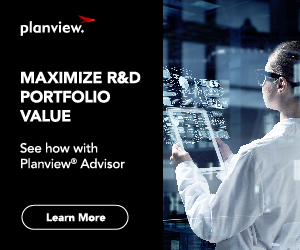
Hinweis: Dies ist ein aktualisierter Beitrag (ursprüngliches Veröffentlichungsdatum Aug. 29, 2018).
Warten Sie, was? Wann ist es schlecht, Risiken zu eliminieren?
Zwischen Zöllen, die Ihre Gewinnspannen zu vernichten drohen, regionalen Konflikten, die die Lieferketten unterbrechen, und dem nächsten wirtschaftlichen Abschwung, der vor der Tür steht, wer würde da bei klarem Verstand ein Risiko eingehen wollen?
Viele Unternehmen, mit denen wir sprechen, sind sehr daran interessiert, ihr Portfolio an Initiativen anhand einer Reihe von Dimensionen zu bewerten, z. B:
- Strategische Passung
- Marktwert
- Entwicklungskosten
- Technisches Risiko
- Kommerzielles Risiko
So weit, so gut. Der Prozess gerät aus den Fugen, wenn Teams, die von der Idee der Einfachheit verführt werden, alle Dimensionen in eine einzige Bewertung für jedes Projekt destillieren.
Hohe strategische Eignung und hoher Marktwert sind "gut" und erhöhen die Punktzahl, während hohe Kosten und Risiken "schlecht" sind und die Punktzahl verringern. Und genau da liegt das Problem.
Dieser Single-Score-Ansatz wird immer Projekte mit niedrigen Kosten und geringem Risiko belohnen. Zu den wahrscheinlichen Ergebnissen einer Prioritätensetzung nach diesem einen Punktwert gehören:
- Ein risikoarmes oder risikoloses Portfolio, das nur Produktlinienerweiterungen und inkrementelle Produktverbesserungen umfasst
- Ein Portfolio, das Partnerschaften in der Spätphase finanziert, die minimale Barmittel erfordern und ein minimales Risiko bergen, aber hohe Lizenzzahlungen erfordern und somit wenig zur Erhöhung der operativen Margen des Unternehmens beitragen.
- Ein Portfolio, das Frühphasen- und Forschungsinitiativen, die mit höheren Risiken behaftet sind und längerfristige Investitionen erfordern, aber auf lange Sicht beträchtliche Renditen einbringen könnten, depriorisiert.
- Ein Unternehmen entscheidet sich für den Rückkauf seiner öffentlichen Aktien, anstatt die Investitionen in risikoreichere Initiativen zu erhöhen (die jährlichen Aktienrückkäufe von US-Unternehmen belaufen sich auf mehr als eine Billion Dollar).
Wenn Unternehmen Stabilität über Innovation stellen, erhöhen sich einige Risiken : Sie laufen Gefahr, langsam Marktanteile zu verlieren und in den Hintergrund ihrer Branche zu geraten. Was sollen wir also tun? Die Lösung liegt in der Einsicht, dass eine effektive F&D-Governance Projekte nicht auf eine einzige Zahl reduzieren kann und sollte.
Weitere Informationen: Einsatz von Datenanalysen: So verstehen Sie die Auswirkungen von Zöllen auf Ihr Produktportfolio
5 Wege zur Bewertung und Kommunikation von Risiken
Die richtige Anzahl an risikoreichen Projekten in Ihrem Portfolio ist wahrscheinlich nicht Null. Die genaue Anzahl hängt von Ihren Unternehmenszielen, Ihrer Risikotoleranz und Ihren finanziellen Reserven ab. Hier finden Sie einige Möglichkeiten, wie Sie das Risiko in Ihrem Portfolio einschätzen und kommunizieren können.
Risiko vs. Belohnung
Anstatt das Risiko in der Gesamtbewertung des Projekts zu verstecken, sollten Sie ein bewährtes Diagramm zum Verhältnis von Risiko und Ertrag erstellen, um die Kompromisse (oder das Fehlen solcher Kompromisse) zwischen Projektrisiko und Projektwert hervorzuheben. Das Management ist vielleicht überrascht, wie viele - oder wie wenige - riskante Projekte das Portfolio enthält.
Wenn Ihr Unternehmen eher risikoscheu ist, könnten Sie auch in Erwägung ziehen, das Risiko in der Sprache der Innovation neu zu formulieren. Bewerten Sie anstelle einer Risikobewertung die technologische Bereitschaft oder den Innovationsgrad der Initiative.
Projekt-Pipeline
Sie können sich auch das Gleichgewicht zwischen risikoreichen und risikoarmen Initiativen im Portfolio ansehen. Konzentrieren sich Ihre risikoreichen Projekte auf einen Geschäftsbereich oder ein Marktsegment? Ist angesichts der zu erwartenden Fluktuation in Ihrem Entwicklungszyklus das Verhältnis zwischen frühen und späten Initiativen angemessen? Sind diese Zuweisungen gewollt oder zufällig?
Ein Swimlane-Diagramm nach strategischem Thema und Lebenszyklusphase kann Ihnen genau zeigen, wo Sie in Innovationen investieren und wo Sie Risiken um jeden Preis vermeiden. Legen Sie Ihre Lebenszyklusphasen entlang der x-Achse (horizontal) an, damit Sie leicht feststellen können, ob Ihre Pipeline die Fluktuation berücksichtigt: In den meisten Fällen werden Sie mehr Initiativen in den früheren Entwicklungsphasen haben wollen, um die Chancen zu erhöhen, dass zumindest einige die Ziellinie überqueren.

Portfolioertrag mit Unsicherheit
Blasendiagramme sind ein echter Hingucker, aber sie beantworten nicht die wichtigen Fragen der Angemessenheit: Haben Sie ein ausreichend ambitioniertes Portfolio, um Ihre mittel- und langfristigen Ziele zu erreichen? Dazu müssen Sie die Projektrenditen für das gesamte Portfolio prognostizieren, um zu verstehen, wie viele risikoreiche und renditestarke Initiativen finanziert werden müssen, um die Chancen zu erhöhen, die Portfolioziele zu erreichen.
Mit den richtigen Finanzmechanismen können Sie die Einnahmen Ihres Portfolios prognostizieren und gleichzeitig die Abnutzung der Entwicklung und kommerzielle Unwägbarkeiten berücksichtigen. Sie könnten zu dem Schluss kommen, dass es unwahrscheinlich ist, Ihre Umsatzziele zu erreichen, selbst wenn alles nach Ihren Vorstellungen läuft (eine unangenehme, aber wichtige Erkenntnis).
Holen Sie sich Ihr Exemplar: Priorisierung des Produktportfolios bei Störungen
Ausgleich zwischen Wert und konkurrierenden Zielen
Kein Unternehmen hat nur eine einzige strategische Überlegung. Wie ein Vierjähriger mit fünf "Lieblingsessen" muss Ihr Unternehmen ein Gleichgewicht finden und sich schließlich zwischen einer Reihe von Zielen entscheiden. Sie werden die Zusammensetzung Ihres Innovationsportfolios gleichzeitig über Dimensionen wie strategische Ziele, Märkte oder Technologieplattformen hinweg feinabstimmen wollen.
Ein Prioritäten-Dashboard ist hier sehr hilfreich, da es diese Ausgabenaufschlüsselung mit einer Umsatzprognose und einem Produktivitätsranking für alle Initiativen verbindet. Sie können Ihren Anlageplan verfeinern und die Auswirkungen auf Ihre konkurrierenden Ziele in Echtzeit beobachten.

Operative Risiken
Schließlich können Sie Diagramme wie ein Flaggendiagramm verwenden, um die Mischung aus Projekten mit hohem und niedrigem Risiko im Hinblick auf anstehende Meilensteine oder Überprüfungen zu ermitteln. Viele Diagramme können verbessert werden, indem ein Aspekt des Projektrisikos eingeblendet wird.
Die Fähigkeit Ihrer Teams, Risiken zu managen und abzumildern, ist begrenzt. Wenn Sie im nächsten Quartal eine Flut von risikoreichen Initiativen haben, sollten Sie diese verteilen und die risikoreichen und weniger risikoreichen Aktivitäten mischen, um die Auswirkungen der risikoreichen Initiativen auf Ihre Projekt- und Ressourcenmanagementprozesse zu verringern.
Augen weit offen: Risiken im Blick
Inzwischen ist klar, dass ich nicht behaupte, dass wir Risiken ignorieren sollten: Es ist von entscheidender Bedeutung, die Projektrisiken im gesamten Portfolio zu bewerten. Die Risikobewertung ermöglicht es den Teams, die größten Risiken für das Portfolio zu identifizieren und ihre Erfahrung und ihr Talent auf die Risikominderung zu konzentrieren.
Wir müssen jedoch unterscheiden zwischen Risiken, die gemildert werden sollten (oft mit Abhilfemaßnahmen, die einen sehr hohen ROI haben) und Risiken, die nur durch den normalen Verlauf der Entwicklung gelöst werden können.
Die Methoden, die ich oben besprochen habe, sind unterschiedlich ausgefeilt, von Monte-Carlo-Methoden, die Tausende von finanziellen Ergebnissen für jedes Projekt simulieren, bis hin zu einfachen Projektinventuren, aber sie sind eher einfach als komplex.
Ein Mehr an methodischer Raffinesse ist nicht immer die Lösung: Brick- und Bar-Ansichten sind transparent, einfach zu erklären und regen Ihre Entscheidungsträger eher zu wichtigen Gesprächen über Portfoliowert und Ausgewogenheit an. Letztendlich sind diese Gespräche wichtiger als die Raffinesse der von Ihnen eingesetzten Analysemethoden.
Wie messen und berücksichtigen Sie das Risiko in Ihrem Produktportfolio? Erkennt und finanziert Ihre Organisation innovativere, weniger sichere Initiativen, um eine langfristige Zukunft zu sichern?
Mehr zu entdecken mit Planview Advisor
Verbinden Sie mit Planview Advisor Strategie und Leistung, um Ihre Kapitalrendite selbst in unsicheren Zeiten zu optimieren.
- Erkennen Sie schnell die Auswirkungen von Zöllen auf Produkte und Rentabilität. Demo ansehen
- Machen Sie Unsicherheit zu Ihrem Wettbewerbsvorteil. Produkttour




